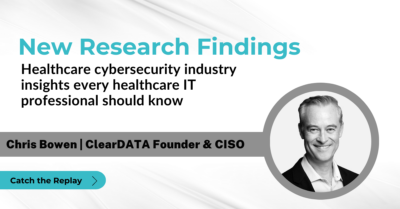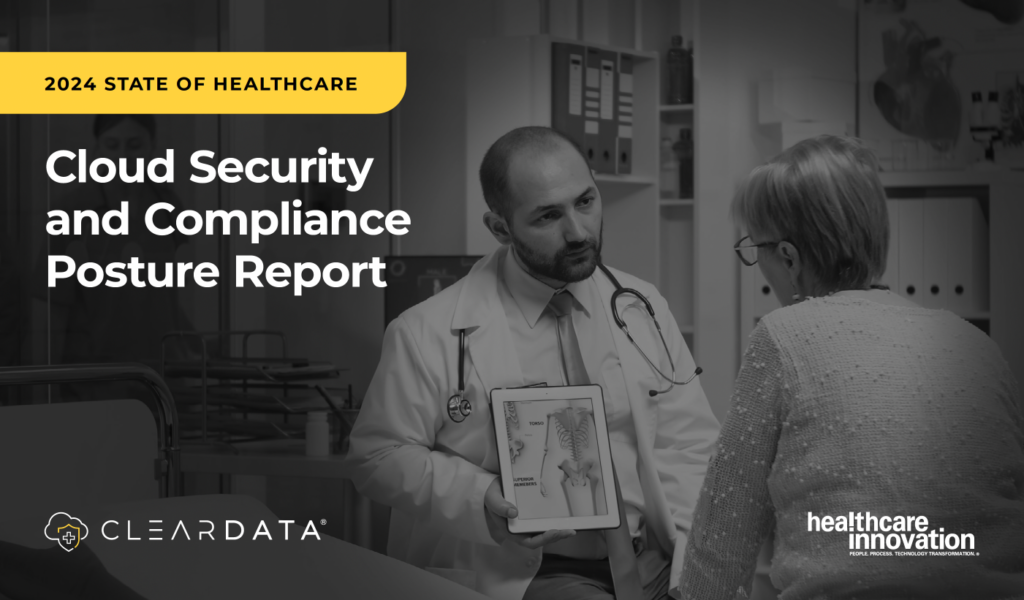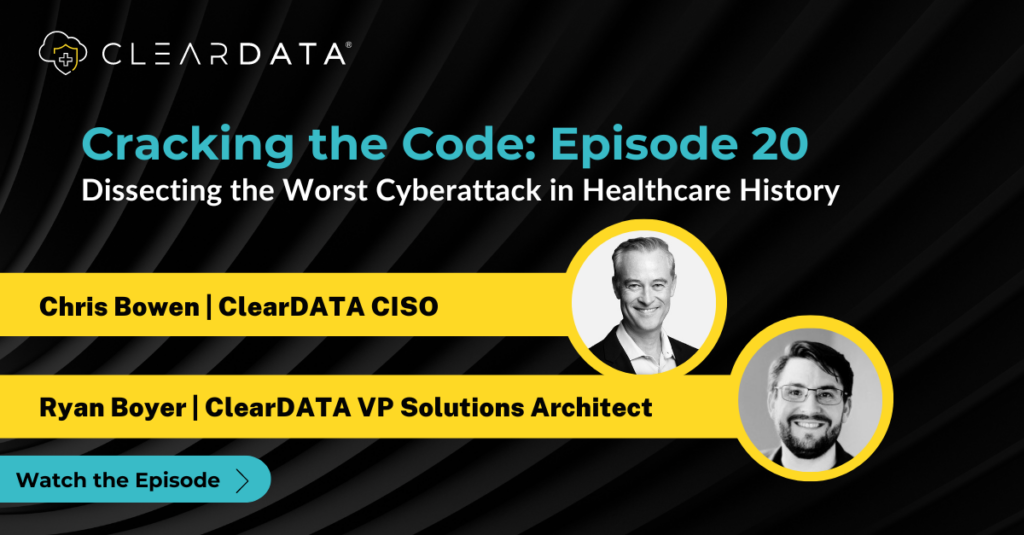Healthcare Cybersecurity Industry Insights: Survey Findings and Expert Opinions
In our recent webinar with Healthcare Innovation, Chris Bowen, ClearDATA’s Founder and CISO, alongside Adam Turinas from Health Launchpad, dove into the latest survey findings on cybersecurity in the healthcare sector. It’s clear cyber security threats in healthcare are only on the rise, and the discussion highlighted critical data points, revealing both strides made, and challenges faced by healthcare organizations in safeguarding sensitive healthcare information in the cloud.
Dive right in and watch the recording or keep reading here for a summary of their insights.
Watch the Recording

State of Healthcare Cybersecurity: Key Insights from Our Recent Survey
With the rapid digital transformation in healthcare, cybersecurity has become increasingly vital. The adoption of cloud technology for data analytics, patient portals, and electronic health records (EMRs) has ushered in new efficiencies, but have also opened doors for potential cyber threats. Ensuring robust cybersecurity measures is crucial not only for compliance but also for protecting patient data and protecting our healthcare infrastructure.
In our latest survey conducted among various healthcare organizations, we aimed to provide a comprehensive overview of the current state of cybersecurity within the industry. Here are some fascinating callouts:
Healthcare Cloud Maturity and Usage
Healthcare organizations are increasingly embracing cloud technology. An impressive 70% of respondents consider themselves to be at either an intermediate or advanced stage of cloud maturity. The primary use cases for cloud technology include data analytics, patient portals, and electronic health records (EHRs). While these findings might not come as a surprise, they affirm the prevalent trends in the industry that healthcare is moving to the cloud!
Confidence in Healthcare Cybersecurity and Compliance
When asked about their confidence in their current security and compliance posture, nearly four in five respondents reported high levels of confidence in their protection programs. Notably, no respondents indicated a complete lack of confidence, which is an encouraging sign on the surface. But is it a false sense of confidence?
Collaboration and Integrated Operations
Solid cybersecurity relies on effective teamwork and seamless operations. We checked how well security and compliance teams work together towards common goals – and it’s impressive! 89% of participants agreed, with 34% strongly agreeing. This highlights the strong collaboration between security and compliance teams in many organizations, aligning objectives and responsibilities.
Healthcare Cybersecurity Budget
Not surprisingly, the budget allocation conversation towards cybersecurity remains a priority for healthcare organizations. Over half (55%) of respondents reported that their organizations allocate between 21% and 40% of their total IT budget to cybersecurity and compliance. Among those with a specific budget allocation for these areas, nearly two-thirds indicated an increase in cybersecurity spending from 2022 to 2023.
This highlights some continued and significant strides in cloud adoption, confidence in security measures, collaborative efforts, and increased budget allocation towards cybersecurity in healthcare. As the healthcare landscape continues to evolve and innovate, staying informed and proactive remains essential for maintaining robust cybersecurity defenses, and security leaders must effectively advocate for cybersecurity to increase in priority to mitigate the risk of healthcare cybersecurity breaches.
Healthcare Cybersecurity Breaches
Let’s turn the conversation toward cybersecurity breaches in healthcare; a particularly relevant topic. Respondents felt that their organizations were prepared for a data leak or data breach, yet nearly one-third still considered it the most concerning security incident, alongside ransomware. 17% percent of respondents indicated it was a high concern, followed by supply chain compromise attacks at 12%. Healthcare Data breaches are a primary concern because they directly impact people’s lives through data theft and extortion attempts.
Additionally, supply chain issues pose significant risks if vendors are not properly vetted, and third-party diligence is not conducted. There are numerous examples, including recent breaches, that highlight how vendors have unknowingly caused data breaches, leading to devastating consequences for patients.
Cloud Misconfigurations
A startling 80% of our respondents experienced at least one cloud misconfiguration in the last year, with 37% reporting two to three misconfigurations.
This is concerning, given that the bulk of data breaches are often tied back to some kind of misconfiguration, whether it’s an issue with MFA, a patch that wasn’t applied, or there was an issue with an encryption algorithm. All of which are risks that can devastate the health system. Due to these misconfigurations, over two-thirds of our respondents improved their IT security systems by enhancing training.

Impact of Misconfigurations
The respondents reported significant impacts on their organizations due to cloud misconfigurations, including operational downtime (cited by 130 respondents), increased scrutiny from regulatory bodies, and strains on internal resources. These impacts are broad and affect many different aspects of the organization. Considering these factors, it’s crucial to assess how concerned organizations should be about the potential impact of misconfigurations on the most important element: patients.
Advice on Addressing Misconfigurations
Regularly reviewing system activity isn’t just a good practice—it’s a necessity, as underscored by the HIPAA regulations from back in 1996. Getting to grips with the tools in your infrastructure and keeping a close, continuous watch on them is critical. If you skip these ongoing checks, that’s when misconfigurations can slip through the cracks and cause real headaches. Take a cyber health platform, for instance; it can keep an eye on your cloud infrastructure 24/7 and alert you to any potential issues before they escalate.
Let’s face it, the reality is that misconfigurations happening. If these hiccups aren’t caught and ironed out before hitting production, they can lead to serious problems. That’s why it’s so important to have thorough testing and validation baked into your processes.
It’s quite surprising—but worth noting—that 22% claim to have zero misconfigurations, a figure we find hard to swallow. Keeping your system in top shape demands vigilance and the right tools, and that’s a commitment both in time and energy that’s worth making!
Are you concerned about a potential misconfiguration in your cloud environment? Schedule a cloud risk checkup today at no cost to you. Our free comprehensive healthcare cloud checkup assesses your environment to identify and remediate specific compliance and configuration risks. You’ll receive a tailored Cloud Risk Report that establishes a baseline assessment of your risk levels in accordance with standards such as HIPAA, HITRUST, NIST, and ISO27001. It also highlights prioritized areas of risk, such as misconfigurations, and their potential impact.
Common Types of Cyberattacks
Unfortunately, due healthcare organizations are frequently targeted by:
- Phishing Attacks: Deceptive emails intended to steal sensitive information.
- Ransomware: Malicious software that encrypts data until a ransom is paid.
- Data Breaches: Unauthorized access to confidential patient information.
The consequences of operational downtime to patient safety can increase the cost of ransomware demands when healthcare organizations rush to restore operations.
Consequences of a Data Breach
The repercussions of a data breach in healthcare can be severe, including:
- Financial Penalties: Significant fines and legal fees.
- Reputation Damage: Loss of patient trust and potential decrease in patient intake.
- Operational Disruption: Interruption of services and potential loss of critical data.
- Patient Safety: Interruption of services and potential loss of critical data can negatively impact patient safety.
Security in Healthcare belongs to everybody!
Healthcare leaders must take proactive steps to bolster their cybersecurity defenses. Here are some recommendations:
- Regular Training: Educate staff about cybersecurity best practices and the latest threats.
- Advanced Security Tools: Invest in sophisticated healthcare cybersecurity solutions, including encryption, multifactor authentication, and real-time threat monitoring.
- Regular Audits: Conduct frequent security audits and ensure you’re euipped with ready audit reporting to identify and address vulnerabilities.
- Incident Response Plans: Develop and regularly update comprehensive incident response plans.
- Collaborative Approach: Foster a culture of collaboration between IT, security, and compliance teams to ensure cohesive security strategies.
The insights provided by Chris Bowen and Adam Turinas underscore the critical importance of robust cybersecurity measures in healthcare. By understanding the current landscape and implementing effective strategies, healthcare organizations can better protect their patients’ data and enhance overall security posture.
Are you concerned about a potential misconfiguration in your healthcare cloud environment?
Don’t wait for cloud unknowns to become cloud nightmares. Fill out the form to request your free Cloud Risk Checkup today.
FAQ
What are the key concerns healthcare organizations face in cybersecurity?
Healthcare organizations face several healthcare cybersecurity challenges including ransomware attacks, data breaches, and cloud misconfigurations. Ensuring compliance with regulations such as HIPAA and maintaining patient trust are also significant concerns.
How can healthcare organizations improve their cybersecurity posture?
Regular training for staff, investing in advanced security tools like encryption and multifactor authentication, conducting frequent security audits, and fostering collaboration between IT and compliance teams are critical steps to improve cybersecurity.
What are the common types of cyberattacks targeting healthcare organizations?
Common cyberattacks include phishing attacks, ransomware, and data breaches. These attacks aim to steal sensitive patient information, disrupt services, and demand ransom payments.
How significant is the role of cloud technology in healthcare cybersecurity, and what are its primary uses?
Cloud technology plays a significant role in healthcare, with primary uses including data analytics, patient portals, and managing electronic health records (EHRs). It offers efficiencies but can also introduce potential cyber threats that need to be managed quickly and efficiently to avoid a data breach.
Why is it essential for healthcare organizations to have a robust incident response plan?
A robust incident response plan is essential to quickly and effectively address security incidents, minimize damage, ensure compliance with regulatory requirements, and maintain patient trust and operational continuity.
Equip yourself with the knowledge to protect your patients and your reputation.



